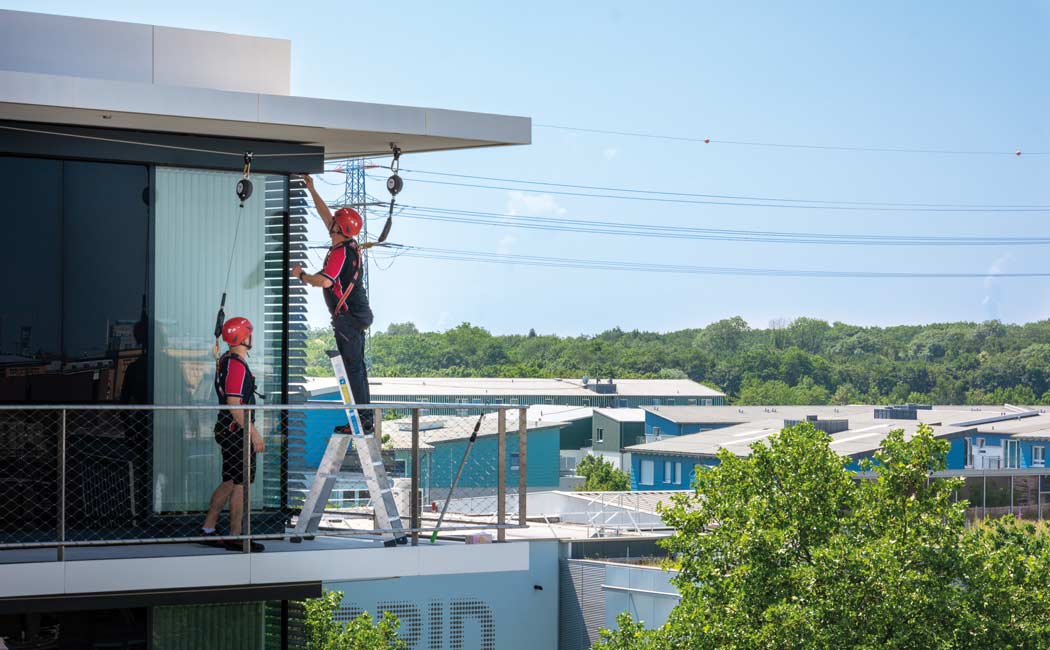- General terms
- Fall danger zone
- Falling edge
- Fall arrest for individuals
- Working alone
- General type approval
- Anchorage device
- Anchorage option
- Working on mobile elevating work platforms
- Arresting system
- Fall-through resistant
- Single anchorage point (anchor)
- Familiarisation
- Enclosed space
- Flat roof safety system
- Risk assessment
- Suspension trauma
- Swing fall
- Rescue concept
- Retention system
- Secondary fall arrest system
- Roof safety hook
- Safety and Occupational Health Coordinator (German: "SiGeKo")
- Thermal isolation
- Anchorage device inspections
- Training
- abZ & DIBt
- DGUV - German statutory accident insurance
- Collective protection
- Standards & regulations
- PPE
- Safety systems
- Access Technology
General terms
Arresting system
Arresting systems are incorporated in EN 363 "Personal fall protection equipment - Personal fall protection systems". Such systems are characterised by the use of personal fall protection equipment (PPE) to arrest falls.
Protects the user from hitting the ground
The use of an arresting system, however, cannot actually prevent a free fall accident from happening. In the event of a fall, an arresting system protects the user from hitting the ground - or other structures located further down.
Arresting systems have their limits
The protection of the user is only guaranteed under certain circumstances. In order to be able to recognise these special circumstances and uphold the level of protection, the user must receive appropriate instruction at least once a year.
Physical and physiological limits
A fall arrest system is subject to the laws of acceleration due to the force of gravity. What that means is: The heavier the user and the longer the fall, the harder the collision when he/she hits the floor.
However, when an arresting system is used, the victim does not hit the ground. Instead, the victim’s fall is stopped by his/her personal fall protection equipment - which releases great force. Without fall-absorbing elements, the resulting energy would go straight through the victim’s body which would result in serious injury or even death - depending on how far he/she falls.
It is mandatory to use lanyard energy absorbers in an arresting system! These reduce the ensuing force to a level which is tolerable to the body (max. 6kN according to EN355).
Limits of the selected equipment (PPE)
Personal fall protection equipment is tested using so-called standard fall parameters. Any situation exceeding the tested criteria is dangerous, since the PPE equipment has not been tested to see whether it can withstand the respective force and continue to provide protection.
There are manifold equipment manufacturers on the market - and even more products - so it is very important for the user to choose protective equipment that is appropriate for his/her area of work and to know its limits.
A simple example to demonstrate where a limit might be met is when we consider the maximum user weight. In most cases, this is somewhere around 136kg to 140kg. In some applications, the maximum user weight is only 100kg - so the user has to watch out. Please refer to the user manual for details.
Local/spatial conditions
When using an arresting system, local conditions must also be taken into account. These may quickly turn out to be a knock-out criterion as they cannot usually be altered. Here are two examples:
A frequent reason for exclusion is that there is not sufficient clearance. An arresting system requires plenty of space below it to be able to reduce the force of a fall. When planning a permanently installed fall protection system on a roof, if there is less than 7m clearance, you should only install and use a system that allows workers to work parallel to the edge of the roof and which protects them through retention.
Another exclusion reason would be if the rescue concept had to be adapted to allow for local conditions. Before starting work, please check whether the present rescue concept is useable. If this is not the case, work may not be commenced until it has been accordingly adjusted.
Always be alert and pay attention to your surroundings. On construction sites, in particular, the spatial conditions can change quickly - posing a special challenge to users.
Arresting systems close the gaps in the safety chain
Assuming that the principles for usage are observed, an arresting system can close the last gap in your safety chain. Arresting systems are extremely individual. Through their usage, you can often reach a workplace or exposed location that you would not have been able to reach otherwise.
However, if you can avoid using an arresting system, you should do so and use a preventive method to secure your workers instead. Collective protection solutions and retention systems are good alternatives.

